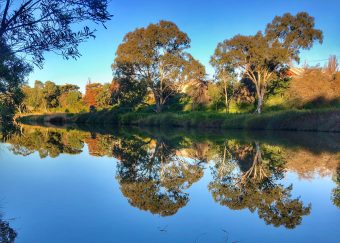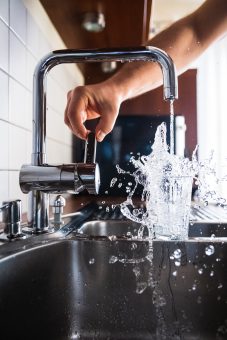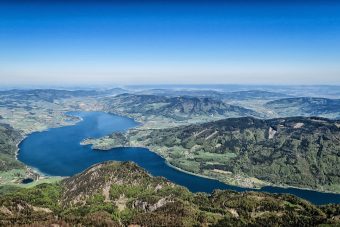
Thinking big to protect the world’s biggest natural capital asset
Water, the source of life – celebrated on World Water Day – is under pressure from climate change. With some regions becoming drier and others ever more exposed to flooding, the need to find and share new ways to husband this vital resource, and measure its value so it can be built into economic development and work creation strategies, is intensifying.
The unsustainable use of the water environment in some of the regions where the EBRD works – nearly 40 economies stretching from Estonia to Egypt, and Morocco to Mongolia – puts it under particularly acute threat.
This is why one of the new areas in the EBRD’s expanded green planning for the half-decade to 2025, as it moves towards making a majority of its investments green, is looking at how best to invest in natural capital, from soil and sustainable land management to water and water ecosystems.
“It’s very clear that natural capital has a vital role for sustainable development in the EBRD regions,” explains the EBRD’s Marta Modelewska. “We operate in countries which are extremely vulnerable to the impacts of climate change. This calls for action. We also need to take care of the ecosystems surrounding our investments – the natural ecosystems that support urban areas.”
Already a leader in climate finance, the EBRD has extensive project experience across water-scarce regions in north Africa and Central Asia, where soil degradation can be a problem for agricultural land, as well as in areas such as the Western Balkans which have seen serious flooding in recent years, and has gradually been scaling up its water husbandry efforts.
Since humans and businesses have a direct impact and dependency on the quality of water through sectors such as fisheries, tourism and food production, the EBRD’s Adonai Herrera Martinez, is also proud of the Northern Dimension Environmental Partnership (NDEP), established 21 years ago, which has improved the water quality of the Gulf of Finland through a total of EUR 1.3 billion support to 23 wastewater treatment plants.
This, he says, remains “a rarity in regions that can still lag in adopting broader sustainability concepts, and preserving and even increasing the value of nature.”
More:
One EBRD project on Morocco’s water-scarce Saiss plain has already demonstrated the benefits of systemic thinking on water supplies, Ms Modelewska says, by tackling the “massive challenge of how agriculture sector can suffer in the longer term because of the lack of available water resource.

“We are supporting the government in using a more sustainable water source rather than groundwater resources which are depleting. They are building a massive infrastructure to make water available to the Saiss plain from different regions that are richer in water.”
The focus now is on expanding this type of systemic approach to benefit broader sustainability – an area of endeavour that is both full of exciting possibilities and, so far, short on definitions and metrics.
Biodiversity is already on the European Union’s policy radar, with ecosystems and biodiversity one of 10 focus European Green Deal areas and sustainable use and protection of water and marine resource one of six environmental objectives in the EU Taxonomy for Sustainable Activities.
Says Mr Herrera Martinez: “our aim is both to find practical applications and encourage partners beyond the EU to take a similar approach. The costs of not doing this would be much higher for our regions.”
But how?
“We are at a very early stage of conceptualising what it means for the EBRD and how we can work in this space,” Ms Modelewska says. What she does know is that over the next few years the Bank will be defining “how we can preserve and enhance natural capital while supporting wider environmental and social benefits, both by scaling up what we have done so far and by innovating. And we will be looking into structuring financial mechanisms that help us work more effectively in this area”.
One part of the work envisaged is in encouraging nature-based solutions. As the EBRD’s Claudia Neuschulz says: “If you restore a wetland, or build an artificial wetland, you then have a natural water filter which will have filtered out some pollutants by the time your water comes to the water treatment plant, so you need to invest less in chemicals and energy-intensive processes to treat the water.
“Another example: a green area in a city will have more water retention. If with climate change you have more heavy rain events, and there’s more water running through your cities, so with more green space you have more opportunities to collect and hold the water.”
Another priority is work with corporate clients to encourage them to “look beyond the factory fence” and measure the water involved not just in their own industrial processes, but also to seek to understand how it relates to water use in the entire water basin in which they are located.
“We need to work on behavioural change, encouraging corporate clients to disclose climate-related information. It is not only that water-intensive industries will face some water risk for their operations, if they run out of water. The issue is broader: they need to look into the economic model applied and how they use the value of nature and understand all the risks related to their current model of economic activities, and to know how to manage these risks,” says Mr Herrera Martinez.
Another step forward will be conceptualising new types of investment in green spaces, evaluating and valorising the water and environmental resources being used so that a project’s environmental impact is correctly priced.

Here the question of defining the price of water arises. Although there are widely accepted measurements for greenhouse gas emissions – key to assessing pollution impacts – there is not yet any similar measurement for measuring the real cost of water and nature-capital assets in different environments.
The EBRD has been among the first to start working on a “shadow water price” to assess this, though this research is at an interim stage and still being refined. It is also working on a valuation model for natural capital assets. “This methodology will in future assist us accounting for natural capital in aquatic and marine systems, and the services these provide to people through carbon sequestration, oxygen production, climate change resilience, provision of food and medicine,” says the EBRD’s Julia Manning.
Innovation is everywhere, in an area developing at speed. As Ms Modelewska notes: “The natural capital theme is very, very new. Part of why we are looking into it now is because we need to think about what will happen after this five-year period, and our work now will help us further expand the scope of our activities into that longer-term future.”
Source: EBRD



